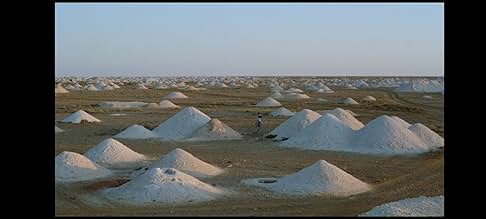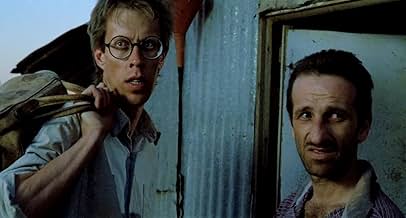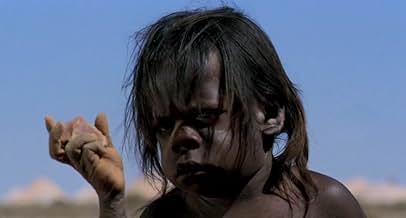Le pays où rêvent les fourmis vertes
Titre original : Wo die grünen Ameisen träumen
- 1984
- Tous publics
- 1h 40min
NOTE IMDb
6,9/10
2,8 k
MA NOTE
Un géologue employé par une société minière australienne se retrouve à contester les droits de certains aborigènes qui croient que leur terre est sacrée.Un géologue employé par une société minière australienne se retrouve à contester les droits de certains aborigènes qui croient que leur terre est sacrée.Un géologue employé par une société minière australienne se retrouve à contester les droits de certains aborigènes qui croient que leur terre est sacrée.
- Réalisation
- Scénario
- Casting principal
- Récompenses
- 2 victoires et 2 nominations au total
Avis à la une
I would classify this movie as being Herzog's most mainstream (which I know isn't saying that much), but still, for a movie that takes place in possibly the most minimalist setting (a stretch of land on the Australian outback littered with the remains of drilling for minerals) I found it absolutely engrossing. This is the movie: A group of aborigines refuse to budge from a small strip of land when a mining company wants to occupy it for drilling purposes; their reason: `This is the land where the green ants dream'. When one of the aborigines is asked why they will not budge even after offered a lucrative settlement, he responds, `How would you like it if someone drove a bulldozer over your church.' Immediately I knew this movie would work. It is a very good film, possibly one of the most finely put together movies I can think of. Rather than being an all and out movie that puts down imperialism, civilization, and national need to exploit resources.it raises some interesting questions about ownership and the present destruction of ancient civilizations. My one fault with the movie is that you know when Herzog is setting things up for an awe-inspired moment, and it does get a little dry toward the end, but still a grand achievement.
I hadn't thought that Herzog was capable of making a good film without Kinski, only some pretentious artsy thing like Heart of Glass.
Well, Green Ants proves me wrong. This is a great film that shows the conflict between white and aboriginal civilizations without being sentimental or condescending to either side. With Hollywood we'd some cliché about noble savages and suchlike, but here you get the feeling of dealing with real human beings.
Oh yeah, the plot deals with an Australian mining company that wants to blow up a sacred site to do mineral exploitation. Herzog avoids stereotyped poses to bring out the situation as it would occur in real life. Plus you get some great shots of the outback.
I plan to lend this one to all my aboriginal friends!
Well, Green Ants proves me wrong. This is a great film that shows the conflict between white and aboriginal civilizations without being sentimental or condescending to either side. With Hollywood we'd some cliché about noble savages and suchlike, but here you get the feeling of dealing with real human beings.
Oh yeah, the plot deals with an Australian mining company that wants to blow up a sacred site to do mineral exploitation. Herzog avoids stereotyped poses to bring out the situation as it would occur in real life. Plus you get some great shots of the outback.
I plan to lend this one to all my aboriginal friends!
I'm invariably surprised when I mention this film to friends that they say they've never seen it. Werner Herzog in Australia? C'mon. How could the great German director of Wozzeck, Nosferatu and other Gothic classics concern himself with a very oblique tale of a development project impeded by Aboriginal Australians who contend that disturbing the green ants dreams by ripping up their habitat will likewise rip the fabric of the universe? The government solution is to give them an airplane which one of the younger members of their tribe eventually manages to take off with a number of the elders on board. Looking over the cast, you likely not recognize names that most of us who don't follow Aussie films know; some of us may know Bruce Spence from the Mad Max films who plays a geologist, but there are many Australian Aborigines. A poignant moment is seen in the court room scene where one Aborigine rises to speak and the judge asks for a translation, only to be told the men is called "the Mute" because there's no one left who understands his tribal language.
The overall effect of the film is wonderfully Herzog with a surrealistic portrayal of the clash of old and new, progress versus conservation and fraught with cultural miscommunication. I really recommend this film for your viewing.
The overall effect of the film is wonderfully Herzog with a surrealistic portrayal of the clash of old and new, progress versus conservation and fraught with cultural miscommunication. I really recommend this film for your viewing.
Herzog is a simple man, easy to read. Hearing him talk of his films, one gets bored easily.
His films are simply conceived, like Lynch's, but once he gets rolling, his intuitions take him to strange, exotic corners of the soul. There he leaves traces that last. I love the man's work, much of it. I love the fact that he really seems to be driven by urges that seem to accidentally result in something that can cross the distribution divide to reach me. This is no small feat; the films I watch that have ideas and matter are what maybe a millionth, a billionth? of the similarly deep insights and artifacts that would have similar effect in me, but which cannot cross that divide.
When I watch his work, some of which I reserve for the future, it is a dip into the film of Herzog. Failures add to this. Risks that did not pan out for him, do for me.
This film has some heavy disadvantages. He is in Australia and he simply does not understand that to photograph the land the way it affects its inhabitants, you have to photograph nothing. Nothing is what matters. But he gives us a tornado. Its beautiful and violent it even fits the story. He gives us unrelenting piles of boring waste. This too is effective in the film, but not of the place.
He misses both the place and he people. He does give us beautiful Aboriginal faces. He does celebrate them. But its from a deeply disturbing patriarchal, colonial perspective. There is some of this in his Peruvian adventures, but it is hidden in his respect for the Jungle. The natives are simply part of the terrain. He cannot do that here. This also suffers in that he felt it necessary to have an on-screen observer who "learns" the value of the place and turns from heading the mining effort to living with the people.
The result is that the film is overt in its sentiments, but everything works against its honesty. We are left with having to accept it locally, each scene as a sort of standalone taste: black patient faces staring out of pilot seats in an airplane given to them; a man on a witness stand testifying in a language no other soul on the planet understands; an old biddy waiting in the sun at a mine opening on the of chance that her beloved doggie will reappear; that tornado; the (overearnest) story of the sleeping green ants whose dreams we are.
This has value in those small pieces, pretty much throughout. But in the large, taken the way he intends it, its just a colonial German peering into a quaint culture as an ordinary tourist would. So it dilutes the greater story, the greater film of the man.
Ted's Evaluation -- 2 of 3: Has some interesting elements.
His films are simply conceived, like Lynch's, but once he gets rolling, his intuitions take him to strange, exotic corners of the soul. There he leaves traces that last. I love the man's work, much of it. I love the fact that he really seems to be driven by urges that seem to accidentally result in something that can cross the distribution divide to reach me. This is no small feat; the films I watch that have ideas and matter are what maybe a millionth, a billionth? of the similarly deep insights and artifacts that would have similar effect in me, but which cannot cross that divide.
When I watch his work, some of which I reserve for the future, it is a dip into the film of Herzog. Failures add to this. Risks that did not pan out for him, do for me.
This film has some heavy disadvantages. He is in Australia and he simply does not understand that to photograph the land the way it affects its inhabitants, you have to photograph nothing. Nothing is what matters. But he gives us a tornado. Its beautiful and violent it even fits the story. He gives us unrelenting piles of boring waste. This too is effective in the film, but not of the place.
He misses both the place and he people. He does give us beautiful Aboriginal faces. He does celebrate them. But its from a deeply disturbing patriarchal, colonial perspective. There is some of this in his Peruvian adventures, but it is hidden in his respect for the Jungle. The natives are simply part of the terrain. He cannot do that here. This also suffers in that he felt it necessary to have an on-screen observer who "learns" the value of the place and turns from heading the mining effort to living with the people.
The result is that the film is overt in its sentiments, but everything works against its honesty. We are left with having to accept it locally, each scene as a sort of standalone taste: black patient faces staring out of pilot seats in an airplane given to them; a man on a witness stand testifying in a language no other soul on the planet understands; an old biddy waiting in the sun at a mine opening on the of chance that her beloved doggie will reappear; that tornado; the (overearnest) story of the sleeping green ants whose dreams we are.
This has value in those small pieces, pretty much throughout. But in the large, taken the way he intends it, its just a colonial German peering into a quaint culture as an ordinary tourist would. So it dilutes the greater story, the greater film of the man.
Ted's Evaluation -- 2 of 3: Has some interesting elements.
The geologist Lance Hackett is employed by an Australian mining company to map the subsoil of a desert area covered with ant hills prior to a possible uranium extraction. His work is impeded by some aborigines who explain that this is the place where the green ants dream.
Werner Herzog makes great films, and he is quite prolific in what he does. His career sees to be divided between unusual drama and documentaries of different cultures. This film, perhaps more than any other of his work, really blends the two. While not a documentary, it really tries to celebrate aborigine culture.
Of all the films based in Australia, this is one of the better ones. It may not be reality, but it is in some ways better than reality. Herzog creates a world that is completely believable.
Werner Herzog makes great films, and he is quite prolific in what he does. His career sees to be divided between unusual drama and documentaries of different cultures. This film, perhaps more than any other of his work, really blends the two. While not a documentary, it really tries to celebrate aborigine culture.
Of all the films based in Australia, this is one of the better ones. It may not be reality, but it is in some ways better than reality. Herzog creates a world that is completely believable.
Le saviez-vous
- AnecdotesThe whole story of the green ants was made up by Werner Herzog, it's not a part of genuine Aboriginal folklore. However the courtroom incident where a secret artifact is revealed, to the bemusement of the judge, is based on a real incident.
- Citations
Lance Hackett: The situation, your Honor, is this man is the the sacred custodian to the secrets of this tribe. And his tribe has died out. He is the sole and final survivor of his people, his clan. They call him the mute, because there is nobody left on this earth for him to speak with.
- Bandes originalesRequiem Op. 48
Music by Gabriel Fauré
Meilleurs choix
Connectez-vous pour évaluer et suivre la liste de favoris afin de recevoir des recommandations personnalisées
- How long is Where the Green Ants Dream?Alimenté par Alexa
Détails
- Date de sortie
- Pays d’origine
- Langue
- Aussi connu sous le nom de
- Where the Green Ants Dream
- Lieux de tournage
- Sociétés de production
- Voir plus de crédits d'entreprise sur IMDbPro
- Durée1 heure 40 minutes
- Mixage
- Rapport de forme
- 1.85 : 1
Contribuer à cette page
Suggérer une modification ou ajouter du contenu manquant

Lacune principale
What is the Spanish language plot outline for Le pays où rêvent les fourmis vertes (1984)?
Répondre





























